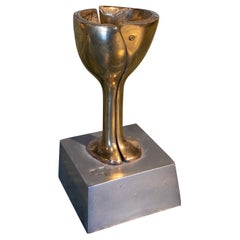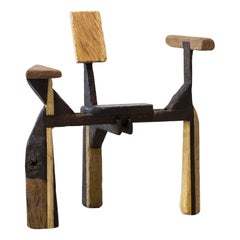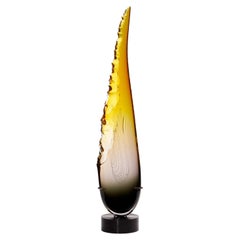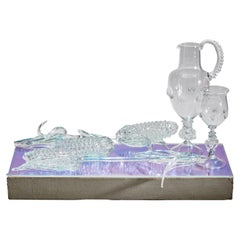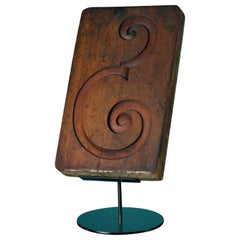European Mounted Objects
to
160
1,031
292
26
254
280
497
318
115
182
140
17
4
8
13
6
30
60
64
18
18
177
136
123
60
59
45
33
22
21
9
8
8
8
6
5
5
4
1
654
461
381
196
150
860
464
1,349
884
471
440
395
Height
to
Width
to
1,349
1,139
1,224
143
47
33
29
22
Place of Origin: European
1980s Bronze Cup with Pedestal by the Artist David Marshall
Located in Marbella, ES
1980s Bronze cup with Pedestal by the Artist David Marshall.
Category
Late 20th Century European Mounted Objects
Materials
Fabric
The Experimental Glyph Chair
Located in Marbella, ES
This sculptural chair evokes the essence of a tribal seat—or perhaps even a throne. Crafted from an eclectic mix of solid wood offcuts sourced from the workshop, each element carries...
Category
2010s European Mounted Objects
Materials
Oak, Pine
Clovis in Grey to Topaz, a Textured Tall Glass Sculpture by James Devereux
By James Devereux
Located in London, GB
'Clovis in Grey to Topaz' is a unique tall glass sculpture by the British artist James Devereux.
Refinement and daring combine within this statue...
Category
2010s Organic Modern European Mounted Objects
Materials
Steel
Single Marble Column Fragment in the Roman Style
Located in Wormelow, Herefordshire
A 16th century roman style marble column fragment circa 1550. This Solomonic marble column is mounted onto a bespoke steel base. A fascinating, ...
Category
16th Century Grand Tour Antique European Mounted Objects
Materials
Marble, Steel
Turf - Harvest, a Glass Still Life Installation Art Work by Elliot Walker
By Elliot Walker
Located in London, GB
'Turf - Harvest' is from the British artist and Blown Away II series winner, Elliot Walker's ongoing body of unique still life artworks. Freehand sculpted in clear glass with iridesc...
Category
2010s Organic Modern European Mounted Objects
Materials
Glass, Art Glass, Blown Glass
Antique Carved Wooden Mould Ex. Tucker Collection
Located in Wormelow, Herefordshire
A mounted antique carved wooden mould from the Tucker collection. This is one of many moulds we are selling from this vast collection assembled by British make-up artist, Christopher...
Category
Late 18th Century Neoclassical Antique European Mounted Objects
Materials
Steel
Two Antique Carved Wooden Scroll Moulds Ex. Tucker Collection
Located in Wormelow, Herefordshire
A pair of mounted antique carved wooden scroll moulds from the Tucker collection. These are just two of many moulds we are selling from this vast collect...
Category
Early 19th Century Victorian Antique European Mounted Objects
Materials
Wood, Hardwood, Boxwood, Fruitwood
Vintage Italian Industrial Glove Mould * Free International Delivery
Located in Portlaoise, IE
A striking original industrial glove mould on circular base. Once used in an everyday capacity in a factory for stretching and forming gloves, reimagined a...
Category
1950s Industrial Vintage European Mounted Objects
Materials
Metal
1960s Very Large Industrial Casting Foundry Mould '2303'
Located in Hook, Hampshire
1960?s very large industrial casting foundry mould (2303)
1960?s very large industrial casting foundry mould – We recently cleared the Victorian warehouses of Derwent Foundry on the...
Category
1960s Vintage European Mounted Objects
Materials
Cast Stone
18th Century Giltwood Sculpture of a Female Nude
By Michelangelo Buonarroti
Located in New York, NY
This giltwood sculpture was carved in the round, probably in southern France or northern Italy in the 1760s. Her pronounced musculature speaks to the ongoing influence of Michelange...
Category
Mid-18th Century Neoclassical Antique European Mounted Objects
Materials
Bronze
Pair of French Bronze Cherubs Sculptures
Located in Southall, GB
Pair of French Bronze Cherubs sculptures playing the drums. Perfect for home decor and interior design.
Category
19th Century Antique European Mounted Objects
Materials
Bronze
$939 Sale Price / set
20% Off
Antique Ravesteijn Delft Tile of Turkish Woman
By Delft
Located in Wormelow, Herefordshire
An antique Delft tile of a woman in Turkish dress, circa 1870, by Ravesteijn of Utrecht, after the original drawing by Nicolas De Nicolay dating to circa...
Category
Late 19th Century Georgian Antique European Mounted Objects
Materials
Clay
1960’s Large Industrial Casting Foundry Mould, 'Mould 1080.21'
Located in Hook, Hampshire
1960’s Large industrial casting foundry mould – (Mould 1080.21)
1960’s Large industrial casting foundry mould – (Mould 1080.21). We recently cleare...
Category
1960s Vintage European Mounted Objects
Materials
Cast Stone
Pair of French Late 18th century Louis XVI Ormolu Candlesticks
Located in Worpswede / Bremen, DE
A very fine pair of Louis XVI period candlesticks of unusual form. Each with an ovoid white marble body issuing a floral spray with a flower head nozzle, supported by three curved mo...
Category
Late 18th Century Louis XVI Antique European Mounted Objects
Materials
Marble, Bronze
1960s Very Large Industrial Casting Foundry Mould '2300'
Located in Hook, Hampshire
1960s very large industrial casting foundry mould (2300)
1960s very large industrial casting foundry mould – We recently cleared the Victorian warehouses of Derwent Foundry on the r...
Category
1960s Vintage European Mounted Objects
Materials
Cast Stone
1960s Very Large Industrial Casting Foundry Mould '2298'
Located in Hook, Hampshire
1960s very large industrial casting foundry mould (2298)
1960s very large industrial casting foundry mould – We recently cleared the Victorian warehouses of Derwent Foundry on the r...
Category
1960s Vintage European Mounted Objects
Materials
Cast Stone
1960s Very Large Industrial Casting Foundry Mould '2310'
Located in Hook, Hampshire
1960’s Very large industrial casting foundry mould (2310)
1960’s Very large industrial casting foundry mould – We recently cleared the Victorian warehouses of Derwent Foundry on the...
Category
1960s Vintage European Mounted Objects
Materials
Cast Stone
1960s Very Large Industrial Casting Foundry Mould '2309'
Located in Hook, Hampshire
1960s very large industrial casting foundry mould (2309)
1960s very large industrial casting foundry mould – We recently cleared the Victorian warehouses of Derwent Foundry on the r...
Category
1960s Vintage European Mounted Objects
Materials
Cast Stone
1960s Very Large Industrial Casting Foundry Mould '2297'
Located in Hook, Hampshire
1960?s very large industrial casting foundry mould (2297)
1960?s very large industrial casting foundry mould – We recently cleared the Victorian warehouses of Derwent Foundry on the...
Category
1960s Vintage European Mounted Objects
Materials
Cast Stone
Table Modern Lamp by Artist Salih Mehchi, Perfect for Christmas
By Salih Mekhici
Located in Alessandria, Piemonte
O/5003 - Unusual and elegant tree shaped Table led lamp, one of the first led lamp, created by the young artist Salih Mehci, very famous in France for his incredible huge lightwe...
Category
Late 20th Century Other European Mounted Objects
Materials
Steel
Sculpture by Johny Mattsson, Denmark, 1950s
Located in Stockholm, SE
Sculpture by Johny Mattsson,
Denmark. 1950s.
Pine and teak.
Stamped.
Measures: H: 36.5 cm / 1' 2 1/2"
W: 11.5 cm / 4 1/2"
D: 11.5 cm / 4 1/2".
Category
Mid-20th Century Mid-Century Modern European Mounted Objects
Materials
Teak, Pine
Metsidian Wall Shelf Made in Obsidian with Copper Finish on Top by Janne Kyttane
By Janne Kyttanen
Located in Beverly Hills, CA
The Metsidian shelf and Metsidian side table are dynamic works that represent a moment in time - an eruption that melds two divergent materials together. The prehistoric evolves into...
Category
21st Century and Contemporary European Mounted Objects
Materials
Copper
1960’s Set of Industrial Casting Foundry Moulds, 'Mould 1080.19'
Located in Hook, Hampshire
1960’s Set of industrial casting foundry moulds – (Mould 1080.19)
1960’s Set of industrial casting foundry moulds – (Mould 1080.19). We recently cleared the Victorian warehouses of Derwent Foundry on the river Derwent in Derbyshire. These amazing sculptural pieces are the result, saving these stunning the ‘male’ mould plugs used to form the ‘female’ shape in the process of sand casting. Each one is lovingly hand cut and shape in various timbers, they can be used as decorative objects on a shelf/table or look striking hung on a wall. Round wheel...
Category
1960s Vintage European Mounted Objects
Materials
Cast Stone
1960’s Large Industrial Casting Foundry Mould – 'Mould 1080.27'
Located in Hook, Hampshire
1960’s Large Industrial Casting Foundry Mould – (Mould 1080.27)
1960’s Large Industrial Casting Foundry Mould – (Mould 1080.27). We recently cleare...
Category
1960s Vintage European Mounted Objects
Materials
Cast Stone
Pair of Marble Obelisks
Located in Los Angeles, CA
Pair of midcentury, Italian, polished marble obelisks atop four, bronze spheres, and mounted on a stepped plinth.
Category
Mid-20th Century Mid-Century Modern European Mounted Objects
Materials
Marble, Bronze
$8,800 / set
Pair of Antique Terracotta Corbels on Stands
Located in Wormelow, Herefordshire
Corbels are conventionally used as an architectural fixture. However, this pair of antique corbels are simply too beautiful to be mounted to a ...
Category
Late 19th Century Regency Antique European Mounted Objects
Materials
Steel
Antique Carved Wooden Mould Ex. Tucker Collection
Located in Wormelow, Herefordshire
A mounted antique carved wooden mould from the Tucker collection. This is one of many moulds we are selling from this vast collection assembled by British make-up artist, Christopher Tucker.
Dating from the late 18th to mid 19th centuries, this wooden mould has been exceptionally hand carved by talented Victorian artisans, these elaborate details originally used to cast details in composition for the frames of pictures and paintings.
This mould is inscribed with design number 4968 to the front and features a beautiful design deeply carved into the wood. This results in a highly ornate and precise compo embellishment that appears as though it has been carved rather than cast. The wooden mould comes with an accompanying custom-made steel display stand.
Christopher Tucker
Christopher Tucker (1941-2022) was an award-winning British make-up artist, specialising in prosthetics for theatre and film. Over his vast career, Tucker worked on a number of famous film and theatrical sets, creating prosthetics for the likes of The Phantom of the Opera, Star Wars and The Company of Wolves as well as the spectacular transformation of John Hurt into The Elephant Man.
Following Tucker’s death in 2022, his expansive collection of film memorabilia...
Category
Late 18th Century Victorian Antique European Mounted Objects
Materials
Steel
Bronze Dore Faces, A Pair
Located in Dallas, TX
A rare pair of Italian bronze dore faces mounted on wood. With acanthus leaves and florals on top of head. Numbered B 1769. Circa 1860.
Category
1860s Antique European Mounted Objects
Materials
Bronze
$895 / set
Alessandro Mendini Contemporary Modern Colored Ceramic Italian TOTEM
By Alessandro Mendini
Located in Madrid, ES
Ceramic TOTEM designed by Alessandro Mendini and edited by Superego, Italy.
Alessandro Mendini (born August 16, 1931, Milan-died February 18, 2019, Milan) was an Italian designer, c...
Category
21st Century and Contemporary European Mounted Objects
Materials
Ceramic
Antique Carved Wooden Mould Ex. Tucker Collection
Located in Wormelow, Herefordshire
A mounted antique carved wooden mould from the Tucker collection. This is one of many moulds we are selling from this vast collection assembled by British make-up artist, Christopher...
Category
Mid-19th Century Neoclassical Antique European Mounted Objects
Materials
Steel
Italian 17th century Ormolu and Bréche Violette marble column.
Located in West Palm Beach, FL
A high quality and most decorative Italian 17th century Ormolu and Bréche Violette marble column. This truly stunning column with all of its original gilding is raised by a mottled e...
Category
17th Century Antique European Mounted Objects
Materials
Marble, Ormolu
Pair of Squirrel Bookends Attributed to Jozef Peeters - Belgium 1930s
By Jozef Peeters
Located in Brussels, BE
Pair of squirrel bookends attributed to Jozef Peeters - Belgium 1930s.
Category
1930s Art Deco Vintage European Mounted Objects
Materials
Metal
19th Century Mosaic Fragment Mounted on Stand
Located in Wormelow, Herefordshire
This antique mosaic on stand is a fragment from history. It was reclaimed from a building in the southeast of England and includes a bespoke steel stand ...
Category
Mid-19th Century Neoclassical Antique European Mounted Objects
Materials
Cement, Marble, Steel
Mounted Marble Coat of Arms
Located in Los Angeles, CA
Hand carved marble shield with a rampant Baroque style lion in custom, later, iron 2" wide banded frame.
Category
Late 18th Century Baroque Antique European Mounted Objects
Materials
Marble, Iron
$13,500
Roman Style 19th Century Mosaic Fragment on Stand
Located in Wormelow, Herefordshire
This roman style mosaic on stand is a fragment from history. It was reclaimed from a building in the southeast of England and includes a bespoke steel st...
Category
Mid-19th Century Neoclassical Antique European Mounted Objects
Materials
Cement, Marble
Saint Apollonia of Alexandria, Patron of Dentistry, 18th Century
Located in North Miami, FL
Early 18th Century Spanish carved-wood polychromed sculpture of Saint Apollonia of Alexandria, Patron of Dentistry. This actual sculpture appears in th...
Category
18th Century Baroque Antique European Mounted Objects
Materials
Gold Leaf
$9,200 Sale Price
20% Off
Sculpture ‘Modul Relief 101’ by Lars Erik Falk, Sweden, 1982
By Lars Erik Falk
Located in Stockholm, SE
Sculpture ‘Modul relief 101’ designed by Lars Erik Falk,
Sweden, 1982.
Lacquered wood.
Measures: H: 29.5 cm / 11 1/2''
W: 84.5 cm / 2' 9 1/4''
Provenance: from the artist'...
Category
Mid-20th Century Mid-Century Modern European Mounted Objects
Materials
Wood, Lacquer
Italian Coral Highly Carved Baroque Parasol Handle Early 19th Century
Located in Sarasota, FL
Italian carved coral parasol handle in Baroque style. The handle dates to early 19th century. Most likely made in Torre del Greco near Naples. Fin...
Category
Early 19th Century Baroque Revival Antique European Mounted Objects
Materials
Coral
Vintage Bishops Pub Sign, Carved Wood, 20th Century
Located in Southall, GB
A vintage carved wooden pub sign representing the bishops mitre carved from pine and decorated with glass cabochons. Circa 1950.
Category
20th Century European Mounted Objects
Materials
Wood
$1,658 Sale Price
20% Off
17th Century Bone 'Flaming Torch' Hearth Brush
Located in London, by appointment only
A very rare carved and turned bone 17th century Flemish hearth brush. Each section made from turned elements, taking the form of a flaming torch.
Low co...
Category
Late 17th Century William and Mary Antique European Mounted Objects
Materials
Bone
Set of 2 Ornate Terracotta Corbels Mounted on Stands
Located in Wormelow, Herefordshire
Though corbels are conventionally used as an architectural fixture, this pair of antique corbels are too beautiful to simply sit on a wall or ceiling. Instead, they have been repurposed as sculpture, brought to life on bespoke steel stands to allow the intricacy of their design to be enjoyed and observed up close on a table, shelf or column. Dating from the late 19th century, these large corbels...
Category
Late 19th Century Regency Antique European Mounted Objects
Materials
Steel
Pair of 18th Century Italian Giltwood Fragment Garniture
Located in Los Angeles, CA
Ostrich egg is 5.5" w. No cracks or repairs.
Category
18th Century Neoclassical Antique European Mounted Objects
Materials
Ostrich Eggshell, Giltwood
Sculpture by Lars Erik Falk, Sweden, 1990s
By Lars Erik Falk
Located in Stockholm, SE
Sculpture designed by Lars Erik Falk,
Sweden, 1990s.
Lacquered steel.
Signed.
Measures: H: 18 cm / 7''
W: 55 cm / 21 3/4''
Provenance: From the artist's estate.
Category
Mid-20th Century Mid-Century Modern European Mounted Objects
Materials
Steel
Chinese Man Sculpture in Murano Glass 1970s
Located in Catania, IT
Chinese man sculpture in Murano glass 1970s
in very good condition, has no chipping or missing parts.
sculpture measure:
Height cm 32
Width at the base 9 cm
Category
1960s Vintage European Mounted Objects
Materials
Murano Glass
Large Marble Obelisk with Brass Mount
Located in Los Angeles, CA
A hand carved, beautifully veined solid, polished marble obelisk mounted on a polished brass base.
Category
19th Century Antique European Mounted Objects
Materials
Marble, Brass
Archangel Sculptures, 17th Century
Located in North Miami, FL
A pair of late 17th Century Italian Baroque carved wood, gold gilded and polychromed Archangel sculptures mounted on Lucite bases.
Category
17th Century Baroque Antique European Mounted Objects
Materials
Gold Leaf
$22,950 / set
Angel Sculptures with Torch Shaped Candleholders, 17th Century
Located in North Miami, FL
A pair of early 17th Century Baroque polychromed carved wood Angel sculptures with torch shaped candleholders.
Category
Early 17th Century Baroque Antique European Mounted Objects
Materials
Gold Leaf
$7,600 Sale Price / set
20% Off
Figura talla facial niño
Located in VALÈNCIA, ES
Talla facial de niño Circa 1.910
Cara tallada sobre peana de hierro y madera
Magnífico detalle en las facciones faciales
Category
1910s Art Deco Vintage European Mounted Objects
Materials
Wood
$817 Sale Price
20% Off
Tinplate Football or Ice Hockey Sports Figures
Located in London, GB
A delightful and highly decorative set of six coloured tinplate sports figures. As they have a kicking action we think they are possibly English or American footballers. If anyone kn...
Category
1930s Art Deco Vintage European Mounted Objects
Materials
Metal
21st Century Sculpture Marble Centerpiece "Coupe" by Arch. Pierre Gonalons
By Pierre Gonalons
Located in massa, IT
Marble centerpiece "Coupe" in Giallo Siena & Grande Antique designed by Arch.Pierre Gonalons & produced by Up&Up for Excelsior Collection.
Diam. cm 45x 17 h
Category
21st Century and Contemporary Modern European Mounted Objects
Materials
Marble
Sculpture of John The Baptist, 16th Century
Located in North Miami, FL
Early 16th Century Spanish gold gilded and polychromed carved wood sculpture of John The Baptist.
Category
16th Century Renaissance Antique European Mounted Objects
Materials
Gold Leaf
$10,000 Sale Price
20% Off
Courtesy Frame Wall Decoration by Laboratorio
Located in Geneve, CH
Courtesy Frame Wall Decoration by Laboratorio
Dimensions: D 15 x W 55 x H 60 cm.
Materials: Satin/galvanized steel and Calacatta Red marble.
Laboratorio is a container where ideas a...
Category
2010s Post-Modern European Mounted Objects
Materials
Marble, Steel
$3,340 / item
Pair of Continental Faux Painted Malachite Wooden Pyramids
Located in Southampton, NY
Pair of continental faux painted malachite wooden pyramids.
Category
1920s Empire Vintage European Mounted Objects
High Cube Thunder Acoustic Furniture by SB26
Located in Geneve, CH
High Cube Thunder Acoustic Furniture by SB26
Dimensions: W 38 x D 48 x H 62 cm
Materials: St Laurent & Arabescato marble legs, leaf gilding, leather.
Weight 30 kg.
Based on the Cube...
Category
2010s Modern European Mounted Objects
Materials
Marble
$9,157 / item
BC - Big Circle, Ceramic Foam Hanging Mirror by Jordan Keaney
By Jordan Keaney
Located in London, GB
The BC Mirror is one of the largest mirrors that Designer Jordan Keaney has made, featuring his signature Ceramic Foam on the front, transforming these mirrors into functional sculpt...
Category
21st Century and Contemporary European Mounted Objects
Materials
Ceramic, Porcelain, Glass, Mirror, Paint
Handmade Golden Rami Sospesi Sculpture by Le Meduse
Located in Geneve, CH
Handmade Red Rami Sospesi sculpture by Le Meduse
Unique piece
Dimensions: W 50, D 60, H 78 cm
Materials: Buxus wood painted
Each model is unique because it is handmade, it can ...
Category
2010s Post-Modern European Mounted Objects
Materials
Other
$3,172 / item
Handmade Red Rami Sospesi Sculpture by Le Meduse
Located in Geneve, CH
Handmade red Rami Sospesi sculpture by Le Meduse
Unique piece
Dimensions: W 50, D 60, H 78 cm
Materials: Buxus wood painted
Each model is unique because it is handmade, it can ...
Category
2010s Post-Modern European Mounted Objects
Materials
Other
$3,172 / item
Jupiter 1 Half Moon by Turbina
Located in Geneve, CH
Jupiter 1 half moon by Turbina
Future archeology
Dimensions: Ø 19.5 cm x H 29.5 cm
Materials: MDF
Jupiter project arises from the idea of the stone as symbol of sacredness. Therefore Jupiter is a modular piece composed by spheres and semi spheres stacked together in multiple combinations, usable as mini-bedside tables or sculptures. It’s based on one of the most primitive, natural and intuitive gestures of the human being: the act of planning up stones on a mound. These ancient constructions...
Category
2010s Modern European Mounted Objects
Materials
Wood
$2,619 / item
Jupiter 3 by Turbina
Located in Geneve, CH
Jupiter 3 by Turbina
Future archeology
Dimensions: Ø 19.5 cm x H58.5 cm
Materials: MDF
Jupiter project arises from the idea of the stone as symbol of sacredness. Therefore Jupiter is a modular piece composed by spheres and semi spheres stacked together in multiple combinations, usable as mini-bedside tables or sculptures. It’s based on one of the most primitive, natural and intuitive gestures of the human being: the act of planning up stones on a mound. These ancient constructions...
Category
2010s Modern European Mounted Objects
Materials
Wood
$5,239 / item
Jupiter 2 by Turbina
Located in Geneve, CH
Jupiter 2 by Turbina
Future archeology
Dimensions: Ø 19.5 cm x H 32 cm
Materials: MDF
Jupiter project arises from the idea of the stone as symbol of sacredness. Therefore Jupiter is a modular piece composed by spheres and semi spheres stacked together in multiple combinations, usable as mini-bedside tables or sculptures. It’s based on one of the most primitive, natural and intuitive gestures of the human being: the act of planning up stones on a mound. These ancient constructions...
Category
2010s Modern European Mounted Objects
Materials
Wood
$3,251 / item
Recently Viewed
View AllMore Ways To Browse
Porcelain Bottle Stoppers
Printers Cabinet
Queen Wilhelmina
Rabbit Carving
Rare Seashells
Rare Swedish Kosta Boda
Regency Bow Front Chest
Renaissance Dragon
Rhino Wood
Rhode Island Furniture
Rockford Furniture
Root Wood Carving
Rose Bowl Gold
Royal Dux On Sale
Royal Insignia
Satsuma China
Satsuma Koro
Scorpion Sculpture
